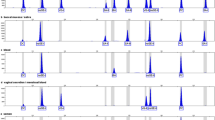Abstract
DNA analysis of various body fluid stains at crime scenes facilitates the identification of individuals but does not currently determine the type and origin of the biological material. Recent advances in whole genome epigenetic analysis indicate that chromosome pieces called tDMRs (tissue-specific differentially methylated regions) show different DNA methylation profiles according to the type of cell or tissue. We examined the potential of tissue-specific differential DNA methylation for body fluid identification. Five tDMRs for the genes DACT1, USP49, HOXA4, PFN3, and PRMT2 were selected, and DNA methylation profiles for these tDMRs were produced by bisulfite sequencing using pooled DNA from blood, saliva, semen, menstrual blood, and vaginal fluid. The tDMRs for DACT1 and USP49 showed semen-specific hypomethylation, and the tDMRs for HOXA4, PFN3, and PRMT2 displayed varying degrees of methylation according to the type of body fluid. Preliminary tests using methylation-specific PCR for the DACT1 and USP49 tDMRs showed that these two markers could be used successfully to identify semen samples including sperm cells. Body fluid-specific differential DNA methylation may be a promising indicator for body fluid identification. Because DNA methylation profiling uses the same biological source of DNA for individual identification profiling, the determination of more body fluid-specific tDMRs and the development of convenient tDMR analysis methods will facilitate the broad implementation of body fluid identification in forensic casework.

Similar content being viewed by others
References
Virkler K, Lednev IK (2009) Analysis of body fluids for forensic purposes: from laboratory testing to non-destructive rapid confirmatory identification at a crime scene. Forensic Sci Int 188:1–17
Bauer M, Polzin S, Patzelt D (2003) Quantification of RNA degradation by semi-quantitative duplex and competitive RT-PCR: a possible indicator of the age of bloodstains? Forensic Sci Int 138:94–103
Bauer M, Patzelt D (2002) Evaluation of mRNA markers for the identification of menstrual blood. J Forensic Sci 47:1278–1282
Juusola J, Ballantyne J (2003) Messenger RNA profiling: a prototype method to supplant conventional methods for body fluid identification. Forensic Sci Int 135:85–96
Juusola J, Ballantyne J (2005) Multiplex mRNA profiling for the identification of body fluids. Forensic Sci Int 152:1–12
Nussbaumer C, Gharehbaghi-Schnell E, Korschineck I (2006) Messenger RNA profiling: a novel method for body fluid identification by real-time PCR. Forensic Sci Int 157:181–186
Juusola J, Ballantyne J (2007) mRNA profiling for body fluid identification by multiplex quantitative RT-PCR. J Forensic Sci 52:1252–1262
Zubakov D, Hanekamp E, Kokshoorn M, van Ijcken W, Kayser M (2008) Stable RNA markers for identification of blood and saliva stains revealed from whole genome expression analysis of time-wise degraded samples. Int J Leg Med 122:135–142
Hanson EK, Lubenow H, Ballantyne J (2009) Identification of forensically relevant body fluids using a panel of differentially expressed microRNAs. Anal Biochem 387:303–314
Setzer M, Juusola J, Ballantyne J (2008) Recovery and stability of RNA in vaginal swabs and blood, semen, and saliva stains. J Forensic Sci 53:296–305
Zubakov D, Kokshoorn M, Kloosterman A, Kayser M (2009) New markers for old stains: stable mRNA markers for blood and saliva identification from up to 16-year-old stains. Int J Leg Med 123:71–74
Holliday R, Pugh JE (1975) DNA modification mechanisms and gene activity during development. Science 187:226–232
Bird AP (1986) CpG-rich islands and the function of DNA methylation. Nature 321:209–213
Russo VEA, Martienssen RA, Riggs AD (1996) Epigenetic mechanisms of gene regulation. Cold Spring Harbor Laboratory Press, Plainview
Tost J (ed) (2008) Epigenetics. Caister Academic Press, Norfolk
Ohgane J, Yagi S, Shiota K (2008) Epigenetics: the DNA methylation profile of tissue-dependent and differentially methylated regions in cells. Placenta 29:S29–S35
Christensen BC, Houseman EA, Marsit CJ, Zheng S, Wrensch MR, Wiemels JL, Nelson HH, Karagas MR, Padbury JF, Bueno R, Sugarbaker DJ, Yeh RF, Wiencke JK, Kelsey KT (2009) Aging and environmental exposures alter tissue-specific DNA methylation dependent upon CpG island context. PLoS Genet 5:e1000602
Schilling E, Rehli M (2007) Global, comparative analysis of tissue-specific promoter CpG methylation. Genomics 90:314–323
Kitamura E, Igarashi J, Morohashi A, Hida N, Oinuma T, Nemoto N, Song F, Ghosh S, Held WA, Yoshida-Noro C, Nagase H (2007) Analysis of tissue-specific differentially methylated regions (TDMs) in humans. Genomics 89:326–337
Igarashi J, Muroi S, Kawashima H, Wang X, Shinojima Y, Kitamura E, Oinuma T, Nemoto N, Song F, Ghosh S, Held WA, Nagase H (2008) Quantitative analysis of human tissue-specific differences in methylation. Biochem Biophys Res Commun 376:658–664
Song F, Mahmood S, Ghosh S, Liang P, Smiraglia DJ, Nagase H, Held WA (2009) Tissue specific differentially methylated regions (TDMR): changes in DNA methylation during development. Genomics 93:130–139
Song F, Smith JF, Kimura MT, Morrow AD, Matsuyama T, Nagase H, Held WA (2005) Association of tissue-specific differentially methylated regions (TDMs) with differential gene expression. Proc Natl Acad Sci USA 102:3336–3341
Illingworth R, Kerr A, Desousa D, Jørgensen H, Ellis P, Stalker J, Jackson D, Clee C, Plumb R, Rogers J, Humphray S, Cox T, Langford C, Bird A (2008) A novel CpG island set identifies tissue-specific methylation at developmental gene loci. PLoS Biol 6:e22
Doi A, Park IH, Wen B, Murakami P, Aryee MJ, Irizarry R, Herb B, Ladd-Acosta C, Rho J, Loewer S, Miller J, Schlaeger T, Daley GQ, Feinberg AP (2009) Differential methylation of tissue- and cancer-specific CpG island shores distinguishes human induced pluripotent stem cells, embryonic stem cells and fibroblasts. Nat Genet 41:1350–1353
Li LC, Dahiya R (2002) MethPrimer: designing primers for methylation PCRs. Bioinformatics 18:1427–1431
Bock C, Reither S, Mikeska T, Paulsen M, Walter J, Lengauer T (2005) BiQ Analyzer: visualization and quality control for DNA methylation data from bisulfite sequencing. Bioinformatics 21:4067–4068
Rohde C, Zhang Y, Jurkowski TP, Stamerjohanns H, Reinhardt R, Jeltsch A (2008) Bisulfite sequencing Data Presentation and Compilation (BDPC) web server—a useful tool for DNA methylation analysis. Nucleic Acids Res 36:e34
Rozen S, Skaletsky H (2000) Primer3 on the WWW for general users and for biologist programmers. Methods Mol Biol 132:365–386
Bitu CC, De Souza Setubal Destro MF, Lopes MA, Jorge J, Graner E, Coletta RD (2008) Dysregulated expression of Hox genes in oral squamous cell carcinomas. Oral presentation #17 at 2008 International Association of Oral Pathologists, San Francisco, USA
Byun HM, Siegmund KD, Pan F, Weisenberger DJ, Kanel G, Laird PW, Yang AS (2009) Epigenetic profiling of somatic tissues from human autopsy specimens identifies tissue- and individual-specific DNA methylation patterns. Hum Mol Genet 18:4808–4817
Sugimoto K, Koh E, Sin HS, Maeda Y, Narimoto K, Izumi K, Kobori Y, Kitamura E, Nagase H, Yoshida A, Namiki M (2009) Tissue-specific differentially methylated regions of the human VASA gene are potentially associated with maturation arrest phenotype in the testis. J Hum Genet 54:450–456
Frumkin D, Wasserstrom A, Budowle B, Davidson A (2010) DNA methylation-based forensic tissue identification. Forensic Sci Int Genet. doi:10.1016/j.fsigen.2010.12.001
Naito E, Dewa K, Fukuda M, Sumi H, Wakabayashi Y, Umetsu K, Yuasa I, Yamanouchi H (2003) Novel paternity testing by distinguishing parental alleles at a VNTR locus in the differentially methylated region upstream of the human H19 gene. J Forensic Sci 48:1275–1279
Nakayashiki N, Kanetake J, Aoki Y (2004) A parent-of-origine detectable polymorphism in the hypermethylated region upstream of the human H19 gene. Int J Leg Med 118:158–161
Acknowledgments
This research was supported by the Basic Science Research Program through the National Research Foundation of Korea (NRF) funded by the Ministry of Education, Science and Technology (2009–0073496 and 2010–0005208).
Conflict of interest
The authors declare that they have no conflict of interest.
Author information
Authors and Affiliations
Corresponding author
Rights and permissions
About this article
Cite this article
Lee, H.Y., Park, M.J., Choi, A. et al. Potential forensic application of DNA methylation profiling to body fluid identification. Int J Legal Med 126, 55–62 (2012). https://doi.org/10.1007/s00414-011-0569-2
Received:
Accepted:
Published:
Issue Date:
DOI: https://doi.org/10.1007/s00414-011-0569-2




